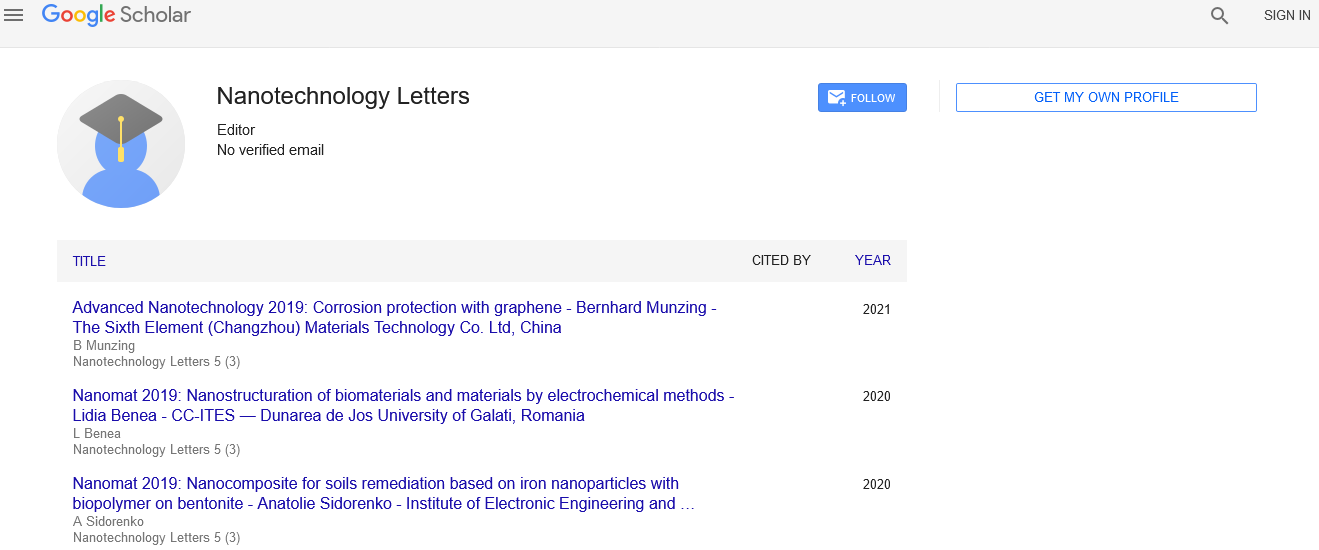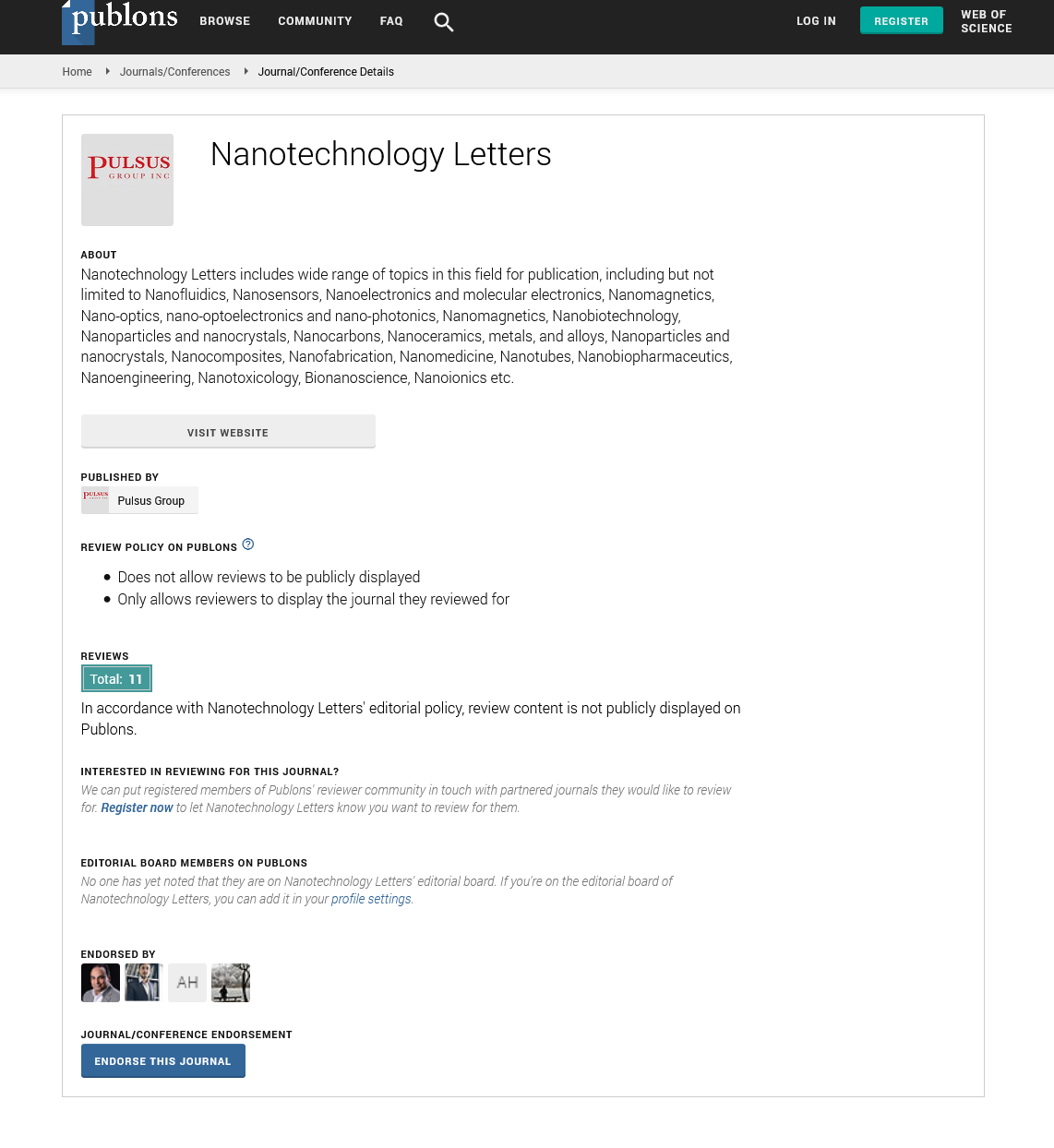Introduction to nanotechnology
Received: 05-Jul-2022, Manuscript No. PULNL-22-5589; Editor assigned: 06-Jul-2022, Pre QC No. PULNL-22-5589 (PQ); Accepted Date: Nov 27, 2022; Reviewed: 12-Jul-2022 QC No. PULNL-22-5589 (Q); Revised: 14-Jul-2022, Manuscript No. PULNL-22-5589 (R); Published: 28-Jul-2022, DOI: 10.37532. pulnl.22.7 (4).5-6.
Citation: Dhiman H. Introduction to nanotechnology. Nanotechnol. lett.2022;7(4):05-06.
This open-access article is distributed under the terms of the Creative Commons Attribution Non-Commercial License (CC BY-NC) (http://creativecommons.org/licenses/by-nc/4.0/), which permits reuse, distribution and reproduction of the article, provided that the original work is properly cited and the reuse is restricted to noncommercial purposes. For commercial reuse, contact reprints@pulsus.com
Abstract
The study of processes that occur at the molecular and nanoscale level is known as nanotechnology. Nanotechnology can be employed in all other scientific disciplines, including biology, chemistry, material science, engineering, and physics, and is particularly useful for smallobjects. The governor of matter on the atomic and molecular scale, which is typically 100 nanometers or smaller, is the focus of this realistic scientific and technology discipline. Among many other characteristics, materials can be effectively modified with nanotechnology to become lighter, stronger, more reactive, durable, sieve-like, or better electrical conductors
Key Words
Nanotechnology; Nanoparticles; Nanotoxicology; Nanomaterials; Nanoelectronics; Scanning tunnelling microscope
Introduction
The term "nanotechnology" refers to those branches of science and engineering that make use of phenomena that occur at the nanometer scale in the planning, representation, manufacture, and application of materials, structures, devices, and systems. Nanotechnology is criticised for having the potential to increase how much energy is consumed, improve the environment, and address important health problems. According to reports, it can significantly boost fabrication productivity at noticeably cheaper costs. According to a proponent of nanotechnology, products will be small, inexpensive, light in colour, and more useful while requiring only a few raw materials and less energy to make
History of Nanotechnology
In order to understand the dichroism phenomena, scientists examined the cup in 1990 using a Transmission Electron Microscope (TEM). The presence of nanoparticles with a diameter of 50 to 100 nm is what causes the dichroism (two colours) that has been seen. According to X-ray examination, these nanoparticles are made of an alloy of silver and gold (Ag-Au) with an approximate 7:3 Ag:Au ratio and 10% Copper (Cu) scattered in a glass matrix. The Au nanoparticles absorb light at a wavelength of about 520 nm, which gives them a red tint. The green hue is a result of colloidal dispersions of Ag nanoparticles with a size>40 nm scattering light, whilst the red-purple colour results from the absorption by the larger particles. One of the earliest artificial nanomaterials is known as the Lycurgus cup. Church windows from the late Middle Ages exhibit a similar phenomenon, displaying dazzling red and yellow colours as a result of the fusion of Au and Ag nanoparticles into the glass. Figure 4 provides an illustration of how these nanoparticles of various sizes affect stained glass windows. Michael Faraday investigated the making and characteristics of colloidal suspensions of "Ruby" gold in 1857. They are among the most fascinating nanoparticles due to their distinctive optical and electrical characteristics. Faraday demonstrated how gold nanoparticles can result in a variety of coloured solutions depending on the illumination.
Modern Nanotechnology
Since Feynman's early theories, nanotechnology had advanced until 1981, when the scientists Gerd Binnig and Heinrich Rohrer created the Scanning Tunneling Microscope (STM) at the IBM Zurich Research Laboratory . The pointed tip of the STM travels so closely to a conductive surface that the electron wave functions of the tip's atoms overlap with the wave functions of the surface atoms. Electrons "tunnel" via the vacuum gap from the atom at the tip into the surface when a voltage is applied (or vice versa). A few years later, in 1990, Don Eigler of IBM in Almaden and his coworkers created the letters of the IBM logo by manipulating 35 individual xenon atoms on a nickel surface using a Scanning Tunnelling Microscope (STM). For "the designing of the STM," Binnig and Rohrer were awarded the 1986 Nobel Prize in Physics. The Atomic Force Microscope (AFM) and Scanning Probe Microscopes (SPM), which are the tools of choice for researchers in nanotechnology today, were created as a result of this invention. At the same time, in 1985, Robert Curl, Harold Kroto, and Richard Smalley found that carbon may also exist as fullerenes, also known as buckyballs, which are extremely stable spheres. When graphite evaporates in an inert atmosphere, carbon balls with the chemical formula C60 or C70 are created. Xu et al. unintentionally discovered a novel class of carbon nanomaterials dubbed carbon dots (C-dots) with size below 10 nm in 2004 while purifying single-walled carbon nanotubes. Due to their benign, abundant, and affordable nature, C-dots with fascinating features have steadily become a rising star as a new nanocarbon component. Nanoscience made breakthroughs in other branches of science like computer, biology, and engineering in the interim. Computer science has advanced thanks to nanoscience and technology, which has reduced the size of a typical computer from a room-sized machine to highly mobile laptops. Electrical engineers advanced to construct intricate electrical circuits down to the nanoscale. At the start of the twenty-first century, interest in the fields of nanoscience and nanotechnology rose. Recent research has demonstrated the enormous potential of nanotechnologies in biomedicine for the detection and treatment of a wide range of human disorders. In this sense, many experts believe that one of the most fascinating areas of application for nanoscience is bio-nanotechnology. Nucleic acids have been a key component in one of the most significant applications of nanotechnology to molecular biology. Paul Rothemund created the "scaffolded DNA origami" in 2006 by using a "one-pot" reaction to increase the complexity and scale of self-assembled DNA nanostructures. Through increasing the effectiveness of conventional chemotherapy medications for a variety of aggressive human tumours, remarkable advancements have also been made in the field of nano-oncology. These developments were made possible by directing a variety of functional molecules, such as nanoparticles, antibodies, and cytotoxic chemicals, at the tumour site. Numerous studies have demonstrated the potential of nanomaterials in this context to influence vital biological processes as autophagy, metabolism, or oxidative stress while also showing anticancer activity. By reducing pollution during the production of materials, creating solar cells that generate electricity at a competitive price, cleaning up organic chemicals that pollute groundwater, and removing Volatile Organic Compounds (VOCs) from the air, nanotechnology has been used to improve the environment and produce more efficient and cost-effective energy. However, the use of computational methods to nanomedicine is still in its infancy and represents a pressing topic for study. The topic of nanoinformatics was created in response to the demand for computational applications at the nanoscale. Predictive analytics and powerful machine-learning algorithms can greatly simplify the creation of more effective nanocarriers. Such algorithms, which predict future data and are frequently used to forecast cellular uptake, activity, and cytotoxicity of nanoparticles, provide predictive knowledge about future data. Other well-known property evaluations being carried out in nanoinformatics include data mining, network analysis, Quantitative Structure-Property Relationship (QSPR), Quantitative Structure-Activity Relationship (QSAR), and ADMET (Absorption, Distribution, Metabolism, Excretion, and Toxicity) predictors
Conclusions
The development of nanoscience and nanotechnology has impacted various scientific fields in a variety of ways. For example, in physics, different microscopes are now able to observe objects at scales ranging from micro to nano. In chemistry, carbon dots can be seen at scales ranging from micro to nano. In computer science, room-sized computers have been replaced by portable, thin laptops. And in biology, single complex biomolecules can be studied at the nano level. Recent developments in physics, chemistry, and material sciences have given a variety of nanomaterials special features that are anticipated to improve the treatment of many malignancies that are now resistant to conventional therapies. They will be able to deliver therapeutic molecules like medicines, proteins, nucleic acids, or immunological agents by acting as nanocarriers, which will be made possible by their inherent cytotoxic activity and/or by their capacity to operate as nanocarriers. These cutting-edge biomedical applications are currently being used in numerous clinical trials and could soon assist significant advancements in the treatment of cancer.






